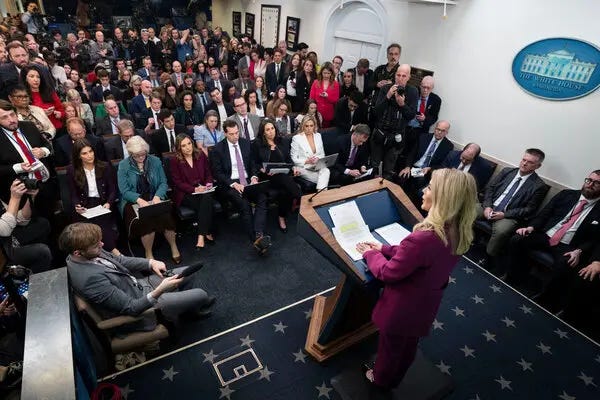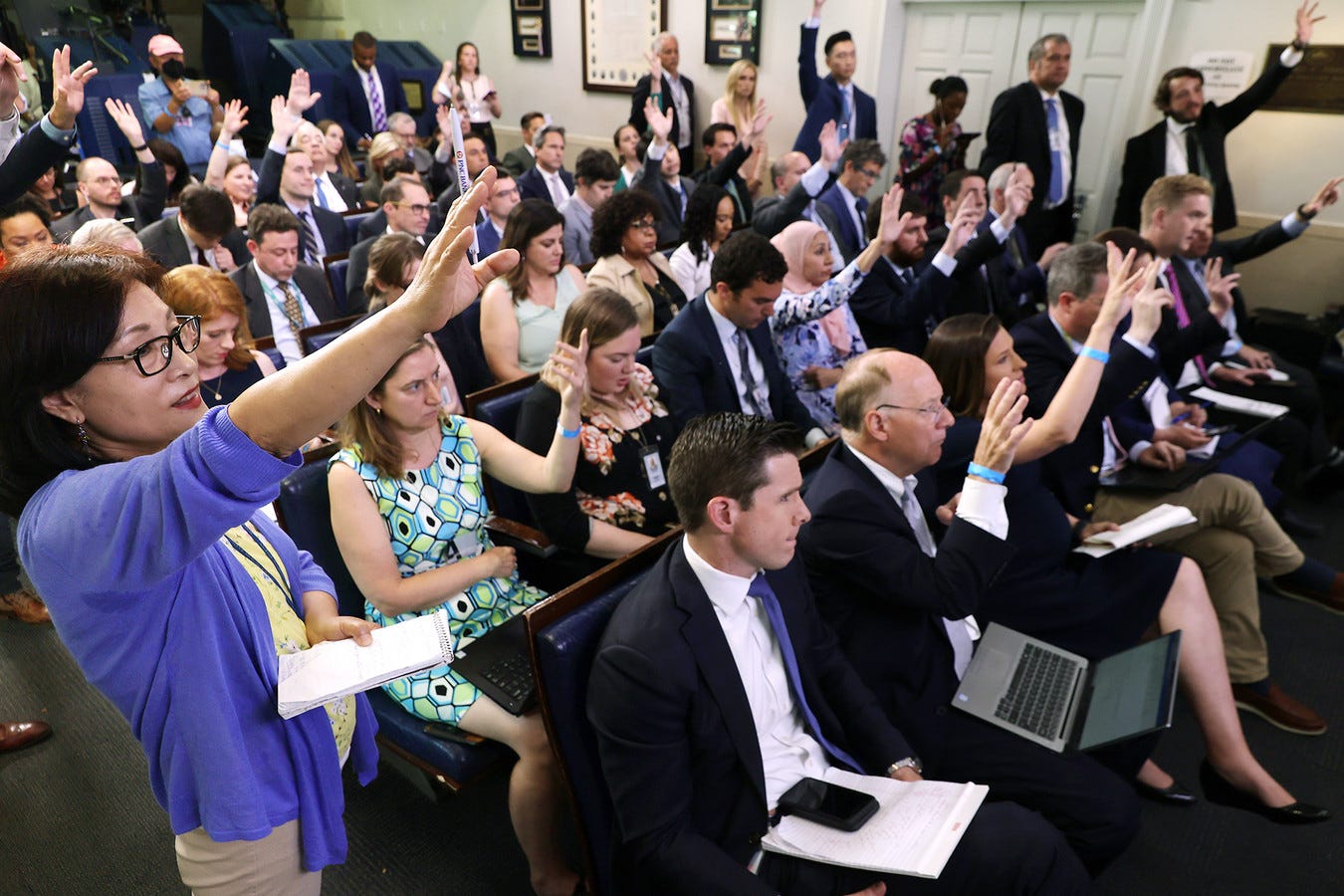The Press vs the President: a Win for the First Amendment?
A few weeks ago, I was standing with a group of reporters outside the White House, waiting for a press aide to let us in.
We were there to cover the president’s signing of an executive order to shrink the Department of Education. But first we had to get past the woman with a clipboard.
Each reporter told her their outlet, she consulted her list, and they walked in.
“Politico.” Check. “The New York Times.” Check. “CNN.” Check.
A reporter from the Associated Press walked up next. “AP?” he asked. She looked down. “No AP today,” she responded. Just a minute before, Brian Glenn — the correspondent for Real America’s Voice, and Marjorie Taylor Greene’s boyfriend — walked in without a problem.
I had just witnessed another twist in the White House grudge match with one of America’s oldest and largest news outlets.
The AP, founded in 1846, is the nation’s most prominent wire service, which means its stories are republished by newspapers across the country. It also maintains the AP Stylebook, a guide that influences linguistic decisions at many other news outlets. Most of the questions in the Stylebook are relatively uncontroversial, like whether to use an Oxford comma. (Well, uncontroversial to most people, at least.)
But language can often be political, and the Stylebook’s January 23 update didn’t sit well with the administration: the AP declined to follow the president’s lead in referring to the Gulf of Mexico as the Gulf of America. The news outlet didn’t want to confuse its global readers, a press release explained, since the body of water was still known by its old name in other countries. The AP would simply acknowledge both names in its reports.
Trump officials responded by revoking the AP’s permanent spot in the White House press pool, the group of reporters who cover every one of the president’s public appearances and disseminate their notes to others. Soon after, the Trump team began denying the AP access even to some events that were open to larger groups of reporters beyond the pool, such as the Education Department event that I attended.
The AP sued, and this week, it received a major — if provisional — victory: Judge Trevor McFadden, a Trump appointee from his first term, ruled that the White House could not limit the AP’s access solely because of the organization’s coverage decisions.
The ruling is only temporary, but it is an extraordinary document. In many parts of the world — and in many eras of history — it would have been laughable to suggest that a group of journalists could be placed on equal footing with a country’s leader, boasting enough legal weight to force their way directly into the president’s seat of power.
And yet, the judge said, that’s exactly what the First Amendment does. As John F. Kennedy put it, the press is “the only business in America specifically protected by the Constitution.” The framers knew that journalists would hold the government’s feet to the fire — which is why they thought it was so important to establish protections for the press, to ensure that no future leader could set the terms of his own coverage.
McFadden made very clear that his ruling wasn’t intended to declare that every journalist is owed the right to walk into the White House, or to interview the president, or to have his questions answered.
But “if the Government opens its doors to some journalists—be it to the Oval Office, the East Room, or elsewhere—it cannot then shut those doors to other journalists because of their viewpoints,” he wrote. “The Constitution requires no less.”
In some countries, journalists who annoy the ruling leaders are killed, tortured, or imprisoned without a second thought. But in the United States, a judge ruled on Tuesday that a president — even the president who appointed him — can’t pick the journalists who cover him based on what they write, all because of a centuries-old sentence. It was a remarkable statement on the enduring power of the First Amendment.
Previous cases, including some in Trump’s first term, had already established limits to the government’s ability to pick the reporters who walk into the White House.
But this case is even more notable because the AP wasn’t just seeking access to the building. It was striving to restore its spot in the press pool, the select group of reporters who join the president at events with a smaller media footprint, like when the president signs orders in the Oval Office.
The AP has long been a mainstay of the pool: in fact, the first known White House pool reporter was an AP journalist, who stood outside while President James Garfield lay bedridden after being shot, ready to give updates to his colleagues. More than a century later, when President George W. Bush spent eight hours circling the skies in Air Force One on 9/11, an AP reporter was one of the five journalists on board.
Hundreds of journalists have standing access to the White House for larger events and press conferences. But only a few are allowed to stand feet from the Resolute Desk, and the AP’s lawsuit was an attempt to regain proximity to that inner sanctum.
Even if it was already established that the government can’t discriminate when handing out White House press passes, you might think that a news outlet would have a harder time pushing their way into the president’s own office.
But McFadden’s decision said they could, citing a decades-old Supreme Court precedent. Perry Education Association v. Perry Local Educators’ Association was a 1983 case involving union access to teacher mailboxes at a public school in Indiana.
In his majority opinion, Justice Byron White set out three types of government-owned property:
A public forum, like a street or a park, where the government has a very narrow ability to restrict the kind of First Amendment activities that take place.
A designated public forum that the government has side aside specifically for open communication, like a meeting room at a public university. Here, the government also has little ability to restrict speech.
And a nonpublic forum, a piece of government property that doesn’t typically host speech, like a museum or an office building. The government doesn’t have to allow speech in these places, but if it does, the First Amendment still prevents officials from discriminating based on viewpoint.
McFadden applied that framework to the White House, ruling that a room like the Oval Office is a nonpublic forum. “This means official authority to restrict expression in the Oval Office is at its zenith,” he said. “But still, there is a limit: Access restrictions must be reasonable and not viewpoint based. So while the AP does not have a constitutional right to enter the Oval Office, it does have a right to not be excluded because of its viewpoint.”
The ruling will not go into effect for another week; in the meantime, the White House has already filed an appeal.
This marks a difference with how Trump handled a similar legal setback in his first term, when a district judge ruled that he couldn’t pull the credentials of then-CNN reporter Jim Acosta. Then the White House accepted defeat without appealing, agreeing to give Acosta back his access.
The administration’s decision to appeal is in line with their more aggressive media strategy this time around. After refusing the AP access to pooled events, the Trump team took the similarly unprecedented step of taking over the pool system entirely, assuming control of assignments that journalists had organized among themselves for decades.
According to Axios, Trump’s advisers are also considering creating their own seating chart for the White House briefing room. Placements there have also historically been set by journalists.
Trump’s moves to dictate access are the continuation of a push-and-pull that dates back centuries, all the way to when Federalists and Democratic-Republicans controlled their own partisan newspapers and distributed scoops accordingly. For many years, press access to the White House remained informal; as recently as the early 1900s, President Theodore Roosevelt would brief a group of reporters while finishing his morning shave.
In the modern era, the White House Correspondents’ Association (WHCA) has negotiated access on behalf of the press corps. Controversies are not unheard of: Richard Nixon banned the Washington Post from White House social events during Watergate; Barack Obama briefly tried to blacklist Fox News from a pooled interview. But every modern administration has allowed the WHCA to decide who makes up the pool and who sits where in the briefing room.
Trump’s administration is the first to challenge that status quo; after McFadden’s decision, some reporters expect the White House will become more aggressive, not less, in attempting to change procedures for press access.
But McFadden’s ruling is also a reminder that, legally speaking, aggression can often backfire. The White House might have been able to get away with removing the AP from the pool, if they had come up with some rigorous new system for deciding access (which they now might do).
Instead, Trump’s team openly acknowledged that they were blocking the AP for the one reason courts have said governments cannot deny access to nonpublic fora: because of the outlet’s content.
“Indeed, the Government has been brazen about this,” McFadden wrote. “Several high-ranking officials have repeatedly said that they are restricting the AP’s access precisely because of the organization’s viewpoint.”
The White House couldn’t help but spike the football, openly bragging that the “Gulf of America” flap was the reason the AP was being kept out of the Oval. For now, at least, that hubris has cost them. Even inside the walls of the Oval Office, the First Amendment still has legs.









I was shocked to learn that the AP was actually using BOTH names and providing context for international readers. That detail makes this whole situation even pettier than I initially thought—possibly the pettiest press story of all time. It's fascinating that Judge McFadden's decision characterized it as the AP's "viewpoint" when what they were doing was explicitly trying NOT to inject a viewpoint. They were being neutral by acknowledging both names with context, but apparently even neutrality is considered extreme in this Orwellian era.
Sure, it's "a major victory" for the First Amendment, but let's not forget that the most-read news organization in the world was still deprived of White House access for several weeks. This reminds me of how easily democratic norms can be eroded, even when courts eventually step in.
That bit about Theodore Roosevelt briefing reporters while finishing his morning shave got me thinking—we should bring that back! That's exactly the kind of authenticity voters today are begging for. People are so tired of perfectly polished politicians that they'll vote against their own interests just to find someone who breaks from the tradition of perfect appearances. Though I realize this would be challenging for the first woman president, who we know will be expected to somehow have a perfect appearance without looking like she's trying, being everything at once or else facing ridicule. But man oh man do we need a woman president so badly.
Side thought: It seems weird to me to not have photographer credits. In this era where AI can generate images from a text prompt, adding photographer credits would not only be fair to the actual humans behind the camera but could also help confirm the authenticity of news images.
Karoline Leaveit will simply refuse to call on AP reporters. And the fight against a fascist America continues….